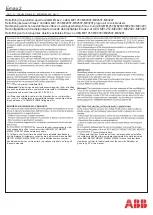
VM1-T
- VACUUM CIRCUIT BREAKER
18
7.5.3 Checking the direction of rotation of the
travel motors on motor-driven
withdrawable parts
•
Move the withdrawable part by hand into a central
position between the test/disconnected position
and the service position.
•
Remove the hand crank.
•
Switch the supply voltage for the travel motor on.
•
Use the local electrical controls to check that the
withdrawable part moves in the correct direction.
Caution:
Do not allow the withdrawable part to run up
against a block when the travel direction is
incorrect! Switch the motor power off immediately
(the travel process functions electrically by a seal-in
system with limit position switch-off).
There may be a danger of injury when the door is
open!
7.5.4 Checking of interlock conditions
(Figures 9/16 and 9/20)
1. The withdrawable part must only be movable
from the test/ disconnected position into the
service position when the circuit breaker is open.
Check this conditions as follows:
•
With the circuit breaker closed, insertion of the
withdrawable part towards the service
position must be blocked after only half a turn
of the crank in the clockwise direction, and the
travel motor on motor-operated withdrawable
parts must not be capable of being switched
on.
Do not use force
(maximum torque 25 Nm)!
2. The withdrawable part must only be movable
from the service position into the test/
disconnected position with the circuit breaker
open.
Check this condition as follows:
•
With the circuit breaker closed, withdrawal
movement of the withdrawable part must be
blocked after only half a turn of the crank in the
anti-clockwise direction, and the travel motor
on motor-operated withdrawable parts must
not be capable of being switched on.
3. Closing of the circuit breaker must only be
possible when the withdrawable part is in the
defined test/disconnected position or service
position.
The control wiring plug 36.1 must previously
have been inserted.
Check this condition as follows:
•
It must not be possible to close the circuit
breaker with the withdrawable part in any
position between the test/ disconnected
position and the service position.
•
Readiness for switching is established
electrically when the service position is
reached by auxiliary switch -BT1 in the
withdrawable assembly switching over.
•
For motion into the test/disconnected
position, the same enabling conditions apply
analogously, in this case by means of auxiliary
switch -BT2 in the withdrawable assembly.
4. It must only be possible to open the circuit
breaker manually in the service position and in
the test/disconnected position on failure of the
supply voltage:
a) Initially by pressing OFF pushbutton 4, until
180 seconds have expired.
b) In subsequent periods, emergency manual
opening with operating lever 28 is possible.
5. Withdrawable parts with order-related blocking
magnet -RL2 may not be moved in case of
control power failure, or when there is no control
power. Do not forcibly move blocked
withdrawable parts! The blocking magnet -RL2 is
only present on manually operated withdrawable
parts (Figure 9/25).
Releasing the blocking magnet -RL2:
•
Remove front plate 1.1,
•
disengage blocking magnet -RL2 by pulling the
magnet armature,
•
while doing so, turn crank 38 about one half
turn (either direction of rotation is
permissible).
The blocking magnet is only active in the test
position and service position. In intermediate
positions it has no effect.
7.6 Spare parts, auxiliary
materials, lubricants
7.6.1 Spare parts
When parts are required, the serial number of the
relevant withdrawable breaker part or circuit
breaker should always be quoted. Setting
instructions are to be requested separately.
Withdrawable assembly of VM1-T:
•
Manually movable withdrawable assembly:
- See drawing GCE 7003570, sheets 1 and 2, for
notes for setting of auxiliary switches -BT2 /
-BT1 and slide blocker.
•
Motor-driven withdrawable parts:
- For notes on settings see drawing GCE 7003571.
•
Blocking magnet -RL2:
- For notes on settings see drawing GCE 7003820,
sheet 1 (table 2).
—
7. Maintenance
Summary of Contents for VM1-T
Page 43: ...MEDIUM VOLTAGE PRODUCTS 43 ...









































